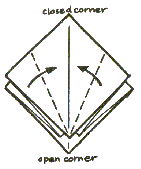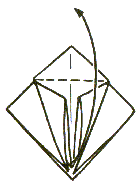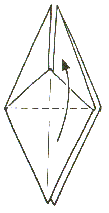

 |
1. Fold up on both diagonals (lines 1 and 2). Unfold paper
after each crease.
2. Fold paper in half to the BACK on line 3. Unfold paper. 3. Fold paper in half to the BACK on line 4. Leave paper folded.
|

4. Grasp paper at the folded edge with both hands in the exact places shown in the drawing. Move your hands to each other until the paper forms a square. Place it down flat. Make sure you have two flaps on each side. If you have one flap on one side and three on the other, flip one flap over. |

5. Place closed corner of the square away from you. Fold the outer edges on the front flaps to the middle crease. Turn the paper over and repeat this with the two flaps on the back. | 
6. Fold the triangle at the top back and forth. The paper looks the same as before but the crease made on the dotted line helps you with the next step. |
||

7. Open the front flaps slightly. Find the loose corner at the bottom and lift it up in the direction of the arrow until you see the crease you made in step |

8. Move the outside edges of the paper to the middle and flatten it into a long diamond. Turn the paper over and repeat step 8 on the back. |

9. Fold the flap over from right to left, like you turn the page of a book. Turn the paper over and repeat this on the back, again folding from right to left |
||

10. Fold the bottom flap up as far as it will go. Turn the paper over and repeat on the back. |

11. Pull the hidden points in the direction of the arrows, one at a time. To make them stay, crease sharply as shown by the dotted lines. |

12. Fold the head down in between the two layers of the neck. You have now folded your pterodactyl. It will flap its wings if you hold it at X with one hand and gently pull the tail back and forth with the other hand. Do not pull the tail up and down. |
||

Hint: If the wings don't flap, then reach inside between a wing and the body and wiggle the wing. Do this on both sides. |
||||